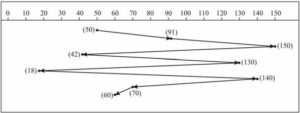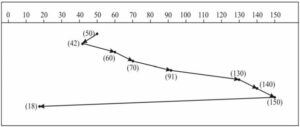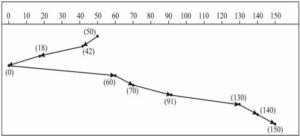Disk Management
Definition
- Disk management refers to the process of organizing, partitioning, formatting, and managing storage devices such as hard drives, solid-state drives (SSDs), and other storage media.
Characteristics
- Different operating systems provide various built-in tools and utilities for disk management, which are briefly discussed below –
-
Windows:
-
Windows operating systems, such as Windows 10 and Windows Server, offer a built-in disk management tool called “Disk Management.” This tool allows one to perform tasks like creating and formatting partitions, extending or shrinking volumes, assigning drive letters, and converting disks between different formats (e.g., Basic and Dynamic disks). We can use the Disk Management tool by right-clicking on the “Start” button and selecting “Disk Management” or by searching for “Disk Management” in the Start menu and following the steps one by one.
-
-
Mac OS:
-
Mac OS provides a disk utility tool called “Disk Utility” for managing disks and partitions. We can use it to format, partition, repair, and encrypt disks. To use this Disk Utility on macOS, go to “Applications” > “Utilities” > “Disk Utility.”
-
-
Linux:
-
Linux distributions typically include various disk management tools, depending on the desktop environment or distribution. Some popular disk management tools for Linux are:-
- GParted: A powerful graphical partition editor that allows you to create, resize, move, and delete partitions.
- fdisk: A command-line tool for creating and managing partitions.
- parted: A command-line partitioning utility with more advanced features than fdisk.
-
-
Unix and BSD:
-
Unix and BSD operating systems provide tools like fdisk and gpart for disk partitioning and management. These command-line tools are similar to their Linux counterparts.
-
-
Chrome OS:
-
Chrome OS is a lightweight operating system primarily designed for web-based applications and Chromebooks.
-
Disk management on Chrome OS is relatively limited compared to other operating systems.
-
Users can manage external storage devices such as USB drives or SD cards by accessing the “Files” app, where they can format and manage the connected storage devices.
-
-
- There are several third-party disk management tools are also available for various operating systems to manage disks.
Free Disk Space Management
Disk Scheduling
Introduction
- Disk scheduling is a key component of the operating system that determines the order in which pending input/output (I/O) requests are serviced by the disk.
- Since disk access time is much slower than CPU and memory, efficient disk scheduling is crucial for system performance, especially when multiple processes are requesting disk access.
Definition
- Disk scheduling in an operating system refers to the way the OS decides the order in which disk I/O requests are serviced.
Characteristics
- The disk scheduling algorithm aims to optimize disk utilization, reduce seek time, and improve overall system performance.
- Disk scheduling is essential for optimizing disk performance.
- The choice of algorithm depends on the system’s requirements for performance, fairness, and complexity.
Types of Disk Scheduling
- There are several types of disk scheduling algorithms, and each disk scheduling algorithm has its own advantages and trade-offs in terms of performance metrics like average seek time, throughput, fairness, and starvation prevention.
- The choice of algorithm depends on the specific system requirements and workload characteristics.
- Some commonly used disk scheduling algorithms are:-
-
-
First-Come, First-Served (FCFS) Disk Scheduling
-
This is the simplest disk scheduling algorithm, where I/O requests are processed in the order they arrive.
-
In this, the disk arm moves to the requested track and fulfills the request.
-
FCFS is easy to implement, but it can lead to poor performance when there are large variations in seek times.
- For example :- The head movement to read data from a disk file in FCFS manner :-
-
-
50, 91, 150, 42,130, 18, 140, 70, 60

-
-
Shortest Seek Time First (SSTF) Disk Scheduling
-
SSTF selects the I/O request with the shortest seek time from the current position of the disk arm.
-
This algorithm minimizes arm movement, resulting in reduced total seek times.
-
SSTF tends to provide better performance than FCFS.
-
It may cause starvation for requests far from the current head position.
- For example :- The head movement to read data from a disk file in SSTF manner :-
50, 91, 150, 42,130, 18, 140, 70, 60
-
-

-
-
SCAN Disk Scheduling (Elevator Algorithm)
- It is also known as the Elevator algorithm.
-
In the SCAN algorithm, the disk arm moves in one/single direction, servicing all requests until it reaches the end, then it reverses direction and serves the remaining requests in the opposite direction.
-
This algorithm prevents starvation and provides a uniform distribution/wait time of service than SSTF. However, requests located in the opposite direction/Edge of the disk arm may experience longer wait times.
- For example :- The head movement to read data from a disk file in a SCAN manner:-
50, 91, 150, 42,130, 18, 140, 70, 60
-

-
-
Circular SCAN (C-SCAN) Disk Scheduling
-
C-SCAN is an improved version of the SCAN algorithm that guarantees a more uniform servicing of I/O requests.
- Like SCAN, but after reaching the end, the head returns to the beginning and starts servicing requests in the same direction.
- This ensures that all requests are serviced without any starvation, although it may lead to a longer total service/wait time.
-
-
LOOK Disk Scheduling
-
The LOOK algorithm is similar to SCAN but does not traverse the entire disk in both directions. Instead, it changes direction when there are no pending requests in the current direction.
-
This reduces the total seek time compared to SCAN, but can still lead to uneven distribution of service and potential starvation.
-
-
Circular LOOK (C-LOOK) Disk Scheduling
-
C-LOOK is an improvement over LOOK, where the disk arm moves only to the last request in the current direction and then jumps to the first request in the opposite direction.
-
This avoids unnecessary traversals of empty disk areas and provides better performance than LOOK.
-
- Other disk scheduling algorithms include Enhanced SCAN (ESCAN), Deadline-Based Scheduling, and N-step SCAN, among others.
-
![]()
0 Comments